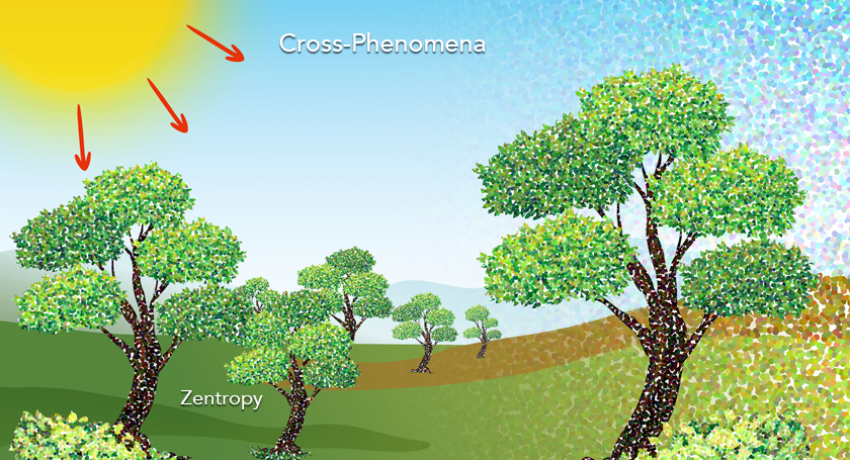Heat from the Sun results in various examples of cross-phenomena such as evaporation of water and photosynthesis for growth of trees and crops. Credit: Elizabeth Floresgomez Murray.
By Jamie Oberdick
A novel theory of cross phenomena could be applied to predict whether a new material would be effective for use in various applications from improved medical ultrasounds to more efficient refrigerators, according to a Penn State researcher.
Cross phenomena are the responses of a system to external stimuli. They occur in virtually any system, from quantum to macro scales. The existence of cross phenomena explains how an external stimulus drives the flow of parts inside a system and how the system’s functionality and effectiveness depend on the driving force and mobility of the flowing parts.
“The majority of material studies involve cross phenomena,” said Zi-Kui Liu, Dorothy Pate Enright Professor of Materials Science and Engineering and author of the study published in Materials Research Letters. “If you set up a temperature gradient across a thermoelectric material, it will generate electricity and thus produce power for electricity such as that used in NASA spacecraft. While if you apply high electric current, it can cause the temperature to drop, which could be useful for refrigeration. These are cross-phenomena.”
Liu noted that cross phenomena are observable in both natural and human-driven systems. One example of a natural system is the Earth itself where the heat from the Sun results in all kinds of cross phenomena, including evaporation of water and photosynthesis for the growth of trees and crops. An example of cross phenomena in a human-driven system is the stock market, where an external factor such as a war can cause fear, resulting in more people wanting to sell stocks and pushing down stock prices, and under extreme conditions bringing the entire market to cross its limit of stability, resulting in a crash.
According to Liu, his new cross phenomena theory goes beyond the phenomenological scientific approach, where observations in experiments are made to describe the relationship of phenomena to each other based on what is observed.
“You can make phenomenological observations but also wonder why it happens,” Liu said. “We understand the fundamental law and say okay, that observation makes sense. But you can also say no, that observation was superficial, there was something actually different than what we thought would happen that requires further investigation. With a better understanding and even new laws, one can predict how stimuli affect a given system in the future.”
The new theory involves what Liu calls Zentropy theory. Zentropy is based on entropy, the part of the second law of thermodynamics that expresses the measure of the disorder of a system that occurs over a period of time when there is no energy applied to keep order. Zentropy considers how entropy occurs over multiple scales within a system by integrating quantum mechanics, statistical mechanics, and experimental measurements of thermodynamics.
“Our work and the work of others has established methods to predict kinetic coefficients, meaning mobility, based on energetics, i.e., thermodynamics,” Liu said. “And the present work on our novel theory of cross phenomena indicates that the cross phenomena are due to the dependence of driving force on other independent variables in addition to its conjugate variable, i.e., thermodynamic quantities. The mobility also depends on all independent variables, but not in terms of the commonly defined cross phenomena. The phenomenological approach is not based on fundamentals and thus is not as rigorous.”
This novel theory of cross phenomena can be used by researchers to guide experimental discovery and provide a theoretical understanding of experimental observations. This could enable researchers to predict the best ways to develop new materials with emergent behavior via quantum mechanics and statistical mechanics, Liu said. Emergent behavior in a system refers to characteristics of the whole that are greater than the sum of its parts.
Liu pointed to one example based on an ultrasound transducer, the hand-held part of an ultrasound machine, that is used to detect a fetus’s heartbeat in the womb.
"The heartbeat vibrates the transducer then it generates electricity via ferroelectrics, so you actually ‘see’ electricity on the screen as an image of the baby,” Liu said. “That's cross phenomena. A mechanical vibration will give you strain, not a classical cross phenomenon, that's just strain. But when the strain is converted to electricity, that's cross phenomena. Often ultrasound images are not clear and rather blurry, but if we can predict how to develop better materials to make a more sensitive transducer, the images will get much better resolution.”
The next step in this study is to research how this novel theory of cross phenomena can be used as a predictive tool to enable more efficient discovery of materials with emergent behaviors including superconductivity, ferroelectricity, and ferromagnetism for applications in energy conversion, refrigeration, and sensors.
This research was supported by the U.S. Department of Energy, Office of Naval Research, the National Science Foundation, and the endowment of Dorothy Pate Enright Professorship.

